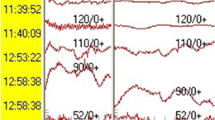Abstract
Accidental perforation of the vertebral pedicle wall is a well-known complication associated with standard approach of pedicle screw insertion. Depending on detection criteria, more than 20% of screws are reported misplaced. Serious clinical consequences, from dysesthesia to paraplegia, although not common, may result from these misplaced screws. Many techniques have been described to address this issue such as somatosensory evoked potentials, electromyography, surgical navigation, etc. Each of these techniques presents advantages and drawbacks, none is simple and ergonomic. A new drilling tool was evaluated which allows for instant detection of pedicle perforation by emission of variable beeps. This new device is based on two original principles: the device is integrated in the drilling or screwing tool, the technology allows real-time detection of perforation through two independent parameters, impedance variation and evoked muscular contractions. A preliminary animal study was conducted to assess the safety and efficacy of this system based upon electrical conductivity. A total of 168 manual pedicle drillings followed by insertion of implants were performed in 11 young porcine lumbar and thoracic spines. The presence or absence of perforation detection, which defines the reliability of the device, was correlated with necropsic examination of the spines. Using this protocol the device demonstrated 100% positive predictive value, 96% negative predictive value, 100% specificity, and 97% sensitivity. Of 168 drillings there were three (1.79%) false-negatives, leading to a minor effraction, cranially in the intervertebral disks, nine (5.36%) screw threads breaching the vertebral cortex when inserting screws, although preparation of the holes did not indicate any perforation, 34 (36%) breaches detected by the instrument and not detected by the surgeon. These results confirm that the impedance variation detection capability of this device offers a simple and effective means to detect perforation in vertebral pedicle, prior to insertion of pedicle screws. Due to the porcine nerve root anatomy, it was not possible to evaluate the added benefit of cross-linking impedance and EMG detection. A future clinical study may further explore the subject of current study.


Similar content being viewed by others
References
Acikbas SC, Arslan FY, Tuncer MR (2003) The effect of transpedicular screw misplacement on late spinal stability. Acta Neurochir 145:949–954
Berry JL, Moran JM, Berg WS, Steffee AD (1987) A morphometric study of human lumbar and selected thoracic vertebrae. Spine 12:362–367
Davne SH, Myers DL (1992) Complications of lumbar spine fusion with transpedicular instrumentation. Spine 17:184–189
Esses SI, Sachs BL, Dreyzin V (1993) Complication associated with technique of pedicle screw fixation. Spine 18:2231–2239
Gertzbein SD, Robbins SE (1990) Accuracy of pedicular screw placement in vivo. Spine 15:11–14
Glossop ND, Hu RW, Randle JA (1996) Computer-aided pedicle screw placement using frameless stereotaxis. Spine 21:2026–2034
Gundanna M, Eskenazi M, Bendo J, Spivak J, Moskovich R (2003) Somatosensory evoked potential monitoring of lumbar pedicle screw placement for in situ posterior spinal fusion. Spine J 5:370–376
Liljenqvist UR, Halm HF, Link TM (1997) Pedicle screw instrumentation of the thoracic spine in idiopathic scoliosis. Spine 22:2239–2245
Lonstein JE, Denis F, Perra JH (1999) Complications associated with pedicle screws. J Bone Joint Surg Am 81:1519–1528
Lonstein JE, et al (1999) Complications associated with pedicle screws. J Bone Joint Surg Am 81:1519–1528
Ludwing SC, Kramer DL, et al (2000) Placement of pedicle screws in the human cadaveric cervical spine. Comparative accuracy of three techniques. Spine 25:1655–1667
Montesano PX, McLain RF, Benson DR (1991) Spinal instrumentation in the management of vertebral column tumours. Semin Orthop 6:237–246
Panjabi MM, Oda T, Wang J (2000) The effects of pedicle adjustments on neural spaces in burst fracture surgery. Spine 25:1637–1643
Panjabi MM, Takata K, Goel V, et al (1991) Thoracic human vertebrae: quantitative three-dimensional anatomy. Spine 16:888–901
Rongming Xu, Nabil A Ebrahim, Yianjia Ou, Richard A Yeasting (1998) Anatomic considerations of pedicle screw placement in the thoracic spine. Spine 23:1065–1068
Roy-Camille R, Saillant G, Mazel C (1986) Plating of thoracic, thoraco-lumbar, and lumbar injuries with pedicle screw plates. Orthop Clin North Am 17:147–159
Sapkas GS, Papadakis SA, Stathakopoulos DP, Papagelopoulos PJ, Badekas AC, Kaiser JH (1999) Evaluation of pedicle screw position in thoracic and lumbar spine fixation using plain radiographs and computed tomography. Spine 24:1926
Vaccaro A, Rizzolo SJ, Balderston RA, et al (1995) Placement of pedicle screws in the thoracic spine Part II An anatomical and radiographic assessment. J Bone Joint Surg Am 77:1200–1206
Welch WC, Rose RD, Balzer JR, Jacobs GB (1997) Evaluation with evoked and spontaneous electromyography during lumbar instrumentation: a prospective study. J Neurosurg 87:397–402
West JL, Ogilvie JW, Bradford DS (1991) Complications of the variable screw plate pedicle screw fixation. Spine 16:576–579
Author information
Authors and Affiliations
Corresponding author
Additional information
An erratum to this article is available at http://dx.doi.org/10.1007/s00586-006-0150-8.
Rights and permissions
About this article
Cite this article
Bolger, C., Carozzo, C., Roger, T. et al. A preliminary study of reliability of impedance measurement to detect iatrogenic initial pedicle perforation (in the porcine model). Eur Spine J 15, 316–320 (2006). https://doi.org/10.1007/s00586-005-1024-1
Received:
Revised:
Accepted:
Published:
Issue Date:
DOI: https://doi.org/10.1007/s00586-005-1024-1




